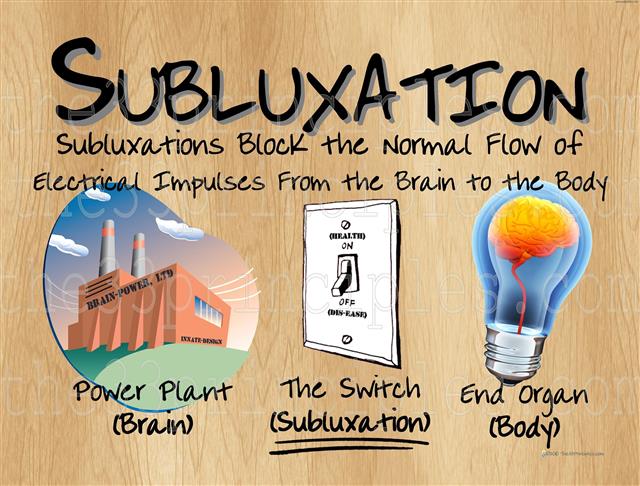Your central nervous system (brain and spinal cord) is responsible for sending messages to every cell, tissue, organ, and system in your body. This communication is made possible by your spinal neurological network. This vast communication network is in charge of virtually every function in your body and determines whether you enjoy food health or disease. The central nervous system is so important that nature built armor around it, your skull and spinal column. However, even with this inborn protection our nervous system can experience interference, injury, or disturbance. We call this a Subluxation.
Your examinations have determined that you have one or multiple subluxations that exist in your spinal neurological network. This could potentially be a very serious threat to your continued overall health and well-being. What caused my subluxations? There are three commonly recognized causes of subluxations: physical trauma, chemical toxins, and emotional stress.
Physical Trauma: Physical trauma is what most patients blame for their subluxations. “I slept wrong…”, “I lifted something too heavy…”, etc. There are many causes of physical stress to our bodies throughout our life from being born, learning how to walk, learning how to ride a bike, slips and falls, car accidents, sports injuries, hobbies, and work injuries. There are multiple physical causes that may be responsible for our subluxations that have accumulated over our lifetime.
Chemical Toxins: Chemical toxins are often overlooked as a cause of our subluxations. Chemicals are a direct poison to our nervous system. Chemical can interfere with or disturb the function of our nervous system just as easily as a trauma. What many of us don’t realize is just how many chemical toxins we expose ourselves to on a daily basis. The list includes: food dyes, sweeteners, preservatives, chemicals in our air and water, hormones in meat, processed foods, caffeine, nicotine, prescriptions, over the counter drugs, cleaning chemicals, perfumes, hair spray, detergents…the list goes on and on. We are a chemical dependent society and these chemicals poison our nervous system resulting in subluxations everyday.
Mental and Emotional Stress: This is the most common cause of subluxations in the world today. Our nervous system filters and processes stress on a moment to moment basis. When our nervous system is overwhelmed by the constant or chronic stress that we endure on a daily basis it breaks down resulting in chronic subluxations. When we are worried, fearful, or stressed. When we experience relationship, money, or career problems. When life doesn’t seem to go our way, it takes a toll on our nervous system. Stress is inescapable in our society and a frequent subluxation producer.
During your path-to-wellness care plan our goal is to remove your subluxations, optimize your health, and provide you with real life strategies to eliminate or reduce your physical, chemical, and emotional stressors to provide you with lasting results and lasting health.
The Broken Wrist Analogy
If you fell and broke your wrist, you would go to the local emergency clinic where the orthopedist would x-ray your wrist, set the bone, cast your wrist, and send you home. If it felt better the next day and you went to the clinic to ask if they would remove the cast what do you think they would say? Most likely, they would laugh at you! Why? How long does it take the bone to heal? In a healthy teenager, a simple wrist fracture would take 4-6 weeks for the bones to heal and the cast would have to remain on for the duration.
At the end of 6 weeks they remove the cast. Would your wrist be at 100%? Would you be able to do everything that you were able to do before the fracture? No, it will take at least another 4-6 weeks to strengthen and stabilize the wrist joint. Now suppose you are a 53 year old woman who slips on the stairs and suffers a complicated fracture of the wrist. In this case, we are talking about 3-4 months to heal the fracture and another 3-4 months of rehabilitation.
So when we recommend your initial care in our office we consider your age and the extend of damage to your nervous system. Our recommendations include the time to heal and time for strengthening and stabilizing the spine to prepare you for wellness care. Why? We don’t heal overnight. Healing is a process, not an event. Chiropractic is a lifestyle, not a treatment. What changes are you willing to make in your lifestyle for better health next year?



 She’s a Mom, has Doctorate in Chiropractic and loves helping people move from pain back to a healthy and active lifestyle.
She’s a Mom, has Doctorate in Chiropractic and loves helping people move from pain back to a healthy and active lifestyle.